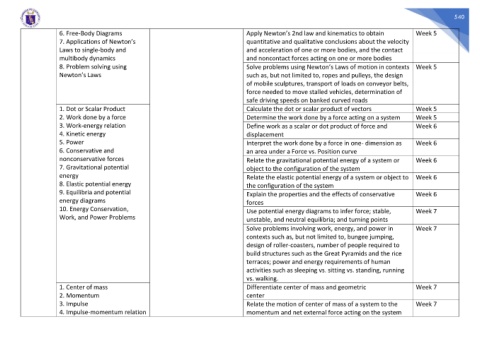Page 540 - Most-Essential-Learning-Competencies-Matrix-LATEST-EDITION-FROM-BCD
P. 540
540
6. Free-Body Diagrams Apply Newton’s 2nd law and kinematics to obtain Week 5
7. Applications of Newton’s quantitative and qualitative conclusions about the velocity
Laws to single-body and and acceleration of one or more bodies, and the contact
multibody dynamics and noncontact forces acting on one or more bodies
8. Problem solving using Solve problems using Newton’s Laws of motion in contexts Week 5
Newton’s Laws such as, but not limited to, ropes and pulleys, the design
of mobile sculptures, transport of loads on conveyor belts,
force needed to move stalled vehicles, determination of
safe driving speeds on banked curved roads
1. Dot or Scalar Product Calculate the dot or scalar product of vectors Week 5
2. Work done by a force Determine the work done by a force acting on a system Week 5
3. Work-energy relation Define work as a scalar or dot product of force and Week 6
4. Kinetic energy displacement
5. Power Interpret the work done by a force in one- dimension as Week 6
6. Conservative and an area under a Force vs. Position curve
nonconservative forces Relate the gravitational potential energy of a system or Week 6
7. Gravitational potential object to the configuration of the system
energy Relate the elastic potential energy of a system or object to Week 6
8. Elastic potential energy the configuration of the system
9. Equilibria and potential Explain the properties and the effects of conservative Week 6
energy diagrams forces
10. Energy Conservation, Use potential energy diagrams to infer force; stable, Week 7
Work, and Power Problems unstable, and neutral equilibria; and turning points
Solve problems involving work, energy, and power in Week 7
contexts such as, but not limited to, bungee jumping,
design of roller-coasters, number of people required to
build structures such as the Great Pyramids and the rice
terraces; power and energy requirements of human
activities such as sleeping vs. sitting vs. standing, running
vs. walking.
1. Center of mass Differentiate center of mass and geometric Week 7
2. Momentum center
3. Impulse Relate the motion of center of mass of a system to the Week 7
4. Impulse-momentum relation momentum and net external force acting on the system

